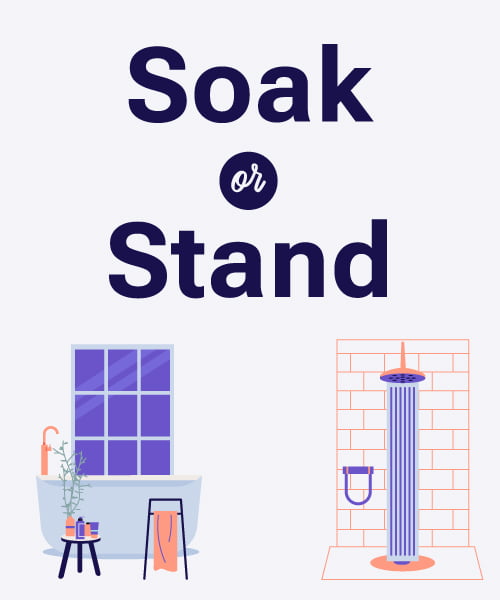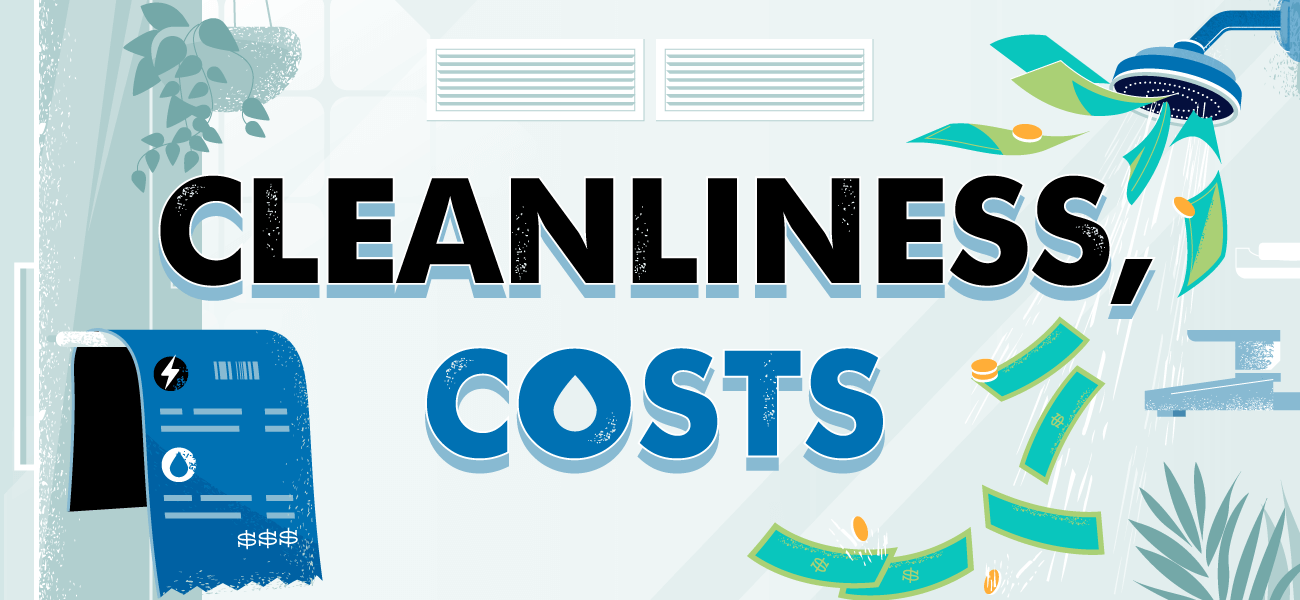
For much of the world, a hot shower is that rare thing: a guilt-free indulgence. It feels good, it leaves you feeling good, and it's said to be good for you.
But in other places, jumping into the shower is not such a straightforward decision. The apparatus, water and energy needed for a warm shower make it an economic no-no. In our latest study, QS Supplies found that there are countries where showering daily for a year would eat up one-third or more of the average local's annual income.
A daily shower is not necessary to main good personal hygiene (indeed, showering too often may be bad for you). But its relative inaccessibility across multiple countries is a stark reminder that billions of people are deprived of the human right "to have physical and affordable access to sanitation, in all spheres of life, that is safe, hygienic, secure, and socially and culturally acceptable." And that a "water or sanitation service does not serve the whole community if it is too expensive," according to the UN.
With water and energy costs soaring in Europe and elsewhere, QS Supplies has crunched the numbers to find out where taking a shower is most and least expensive around the world - and in which countries a year of hot showers is most affordable compared to the average salary.
What We Did
QS Supplies calculated the annual cost of taking a warm shower every day using electricity usage costs from GlobalPetrolPrices and water usage prices from various online sources. We then used World Bank figures to compare the annual cost of showering to the average annual income in each country in order to determine the overall affordability of showering daily in each country.
Key Findings
- A year of daily hot showers costs $802 in Denmark — the most expensive of any country.
- The UK is the 9th most expensive ($573), and the U.S. is 36th ($264).
- Egypt and Suriname have the cheapest annual shower costs ($33 per year for a daily hot shower).
- A year of hot showers in Rwanda costs 46.17% of the average annual income — the worst affordability in the world.
- Norway has the most affordable annual shower costs, equating to 0.31% of the average local income.
The Cost of a Daily Shower in the U.S. is Global Average — the UK Cost is Far More
In the UK, around 18% of energy consumption goes on heating water, and around 68% of household water usage is from bathroom taps and shower heads, according to Waterwise. But the cost and availability of water and heating energy varies dramatically around the world. Here are the annual costs of a daily shower for every country with available data.
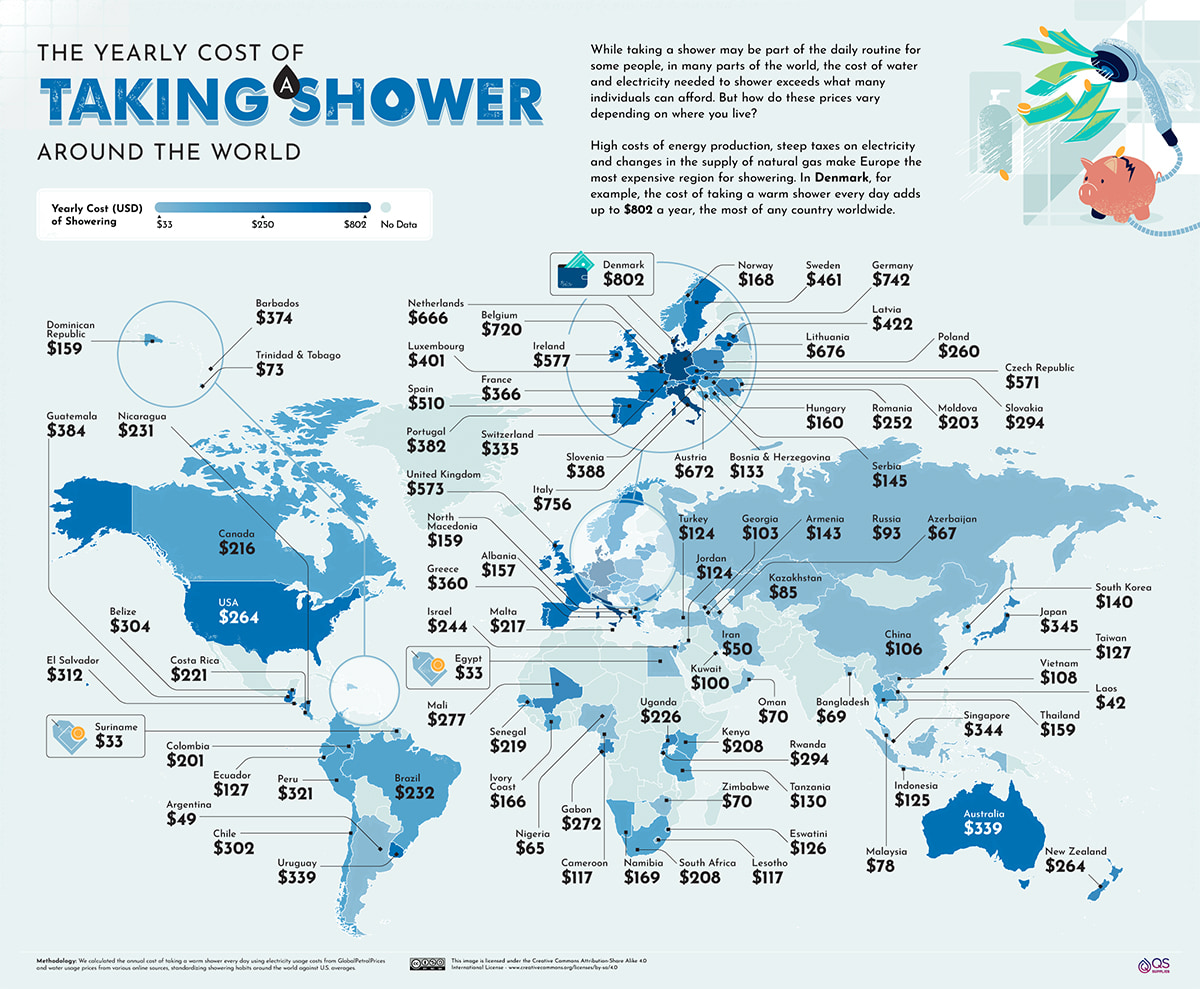 Click here to view full
size
Click here to view full
size
The average cost across the 89 countries on our map is $260 per year. This is just short of the U.S. average of $264: $230 for electricity and $33.72 for water. This figure also gives Americans the third-best deal when compared to average national income. Perhaps that's just as well since the daily or near-daily shower has been considered essential since the rise of "a new class of office drones working in close quarters" in the early 20th century - when advertisers of soaps took advantage by playing on workers' fear of being smelled by the guy at the next desk. Rinse and repeat, anyone?
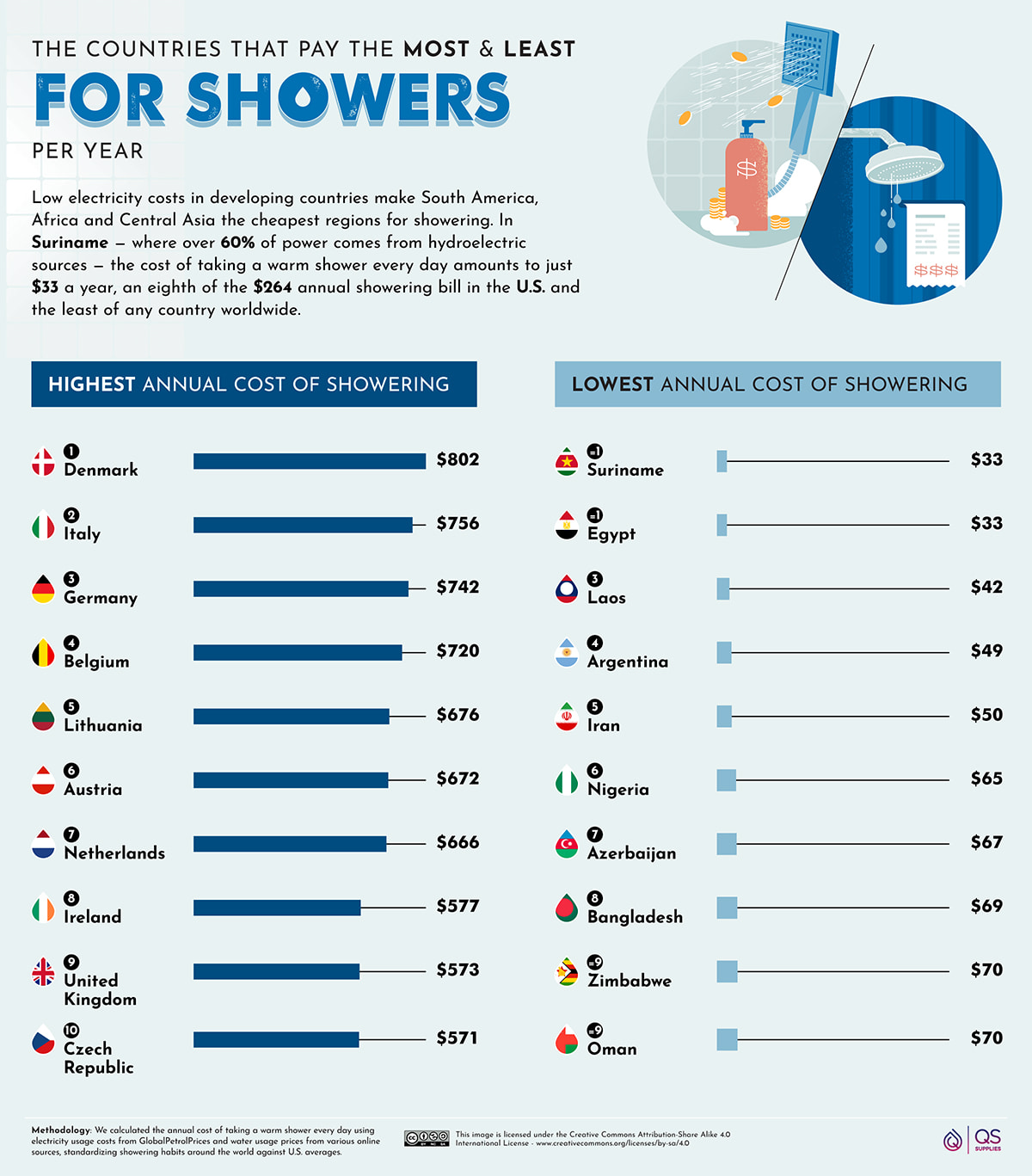 Click here to view full
size
Click here to view full
size
Denmark, one of the world's richest countries with the 17th highest cost of living in general, has the highest cost per shower. Energy crisis-related price hikes in second-highest Italy have been so high that small businesses have taken to displaying their utility bills in their front windows. In the UK, where William Feetham devised the first mechanical shower in 1767, the annual cost of a daily shower is $573.
Norway Has the World's Most Affordable Shower
The example of Denmark - a wealthy country with high energy costs - goes to show that an expensive shower needn't be unaffordable, just as cheaper shower costs may be too much for those on a low income. To determine which countries have the most and least affordable daily shower, we compared local energy prices against the average local net income around the world. The percentage figures in the tables below refer to how much of the average individual's income each year would be spent on showering, assuming a daily hot shower in 59.8 litres of water.
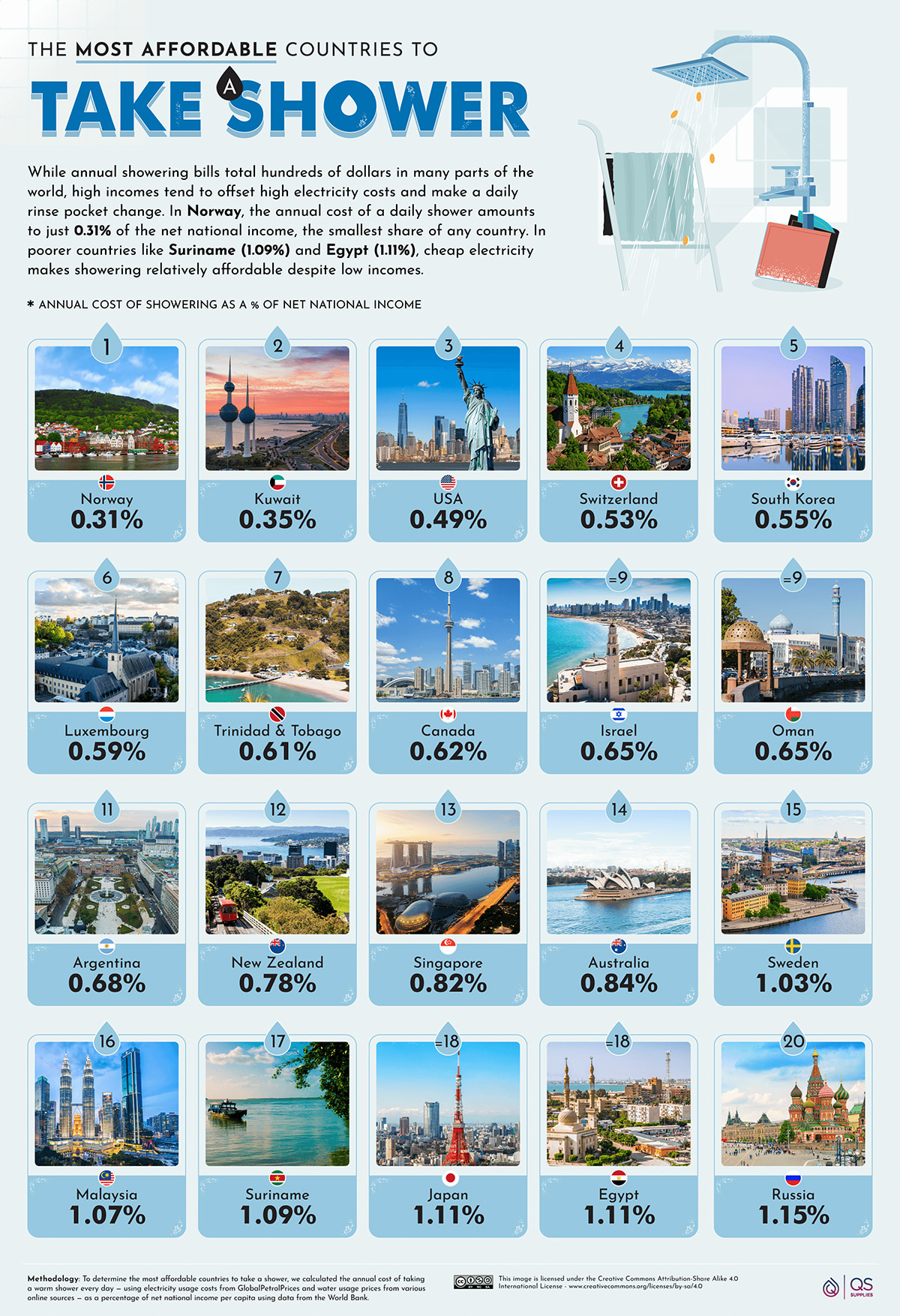 Click here to view full
size
Click here to view full
size
Norway offers the best value daily shower, thanks to below-average bills on a high adjusted net income per capita of $53,514. The relatively low cost of energy in Norway has long been an exception to the country's generally high cost of living, thanks to the country's strong hydropower infrastructure. But due to low rainfall levels in 2022, energy reserves are low, creating a curious rhyme between the lack of precipitation from the skies and an increased cost of taking a shower.
But despite this rise in prices, government subsidies and tactical use of off-peak energy have kept Norwegian bills lower than in much of the world. Meanwhile, Argentina has a relatively low average income but maintains the 11th-best value in the world due to healthy subsidies for bill-payers.
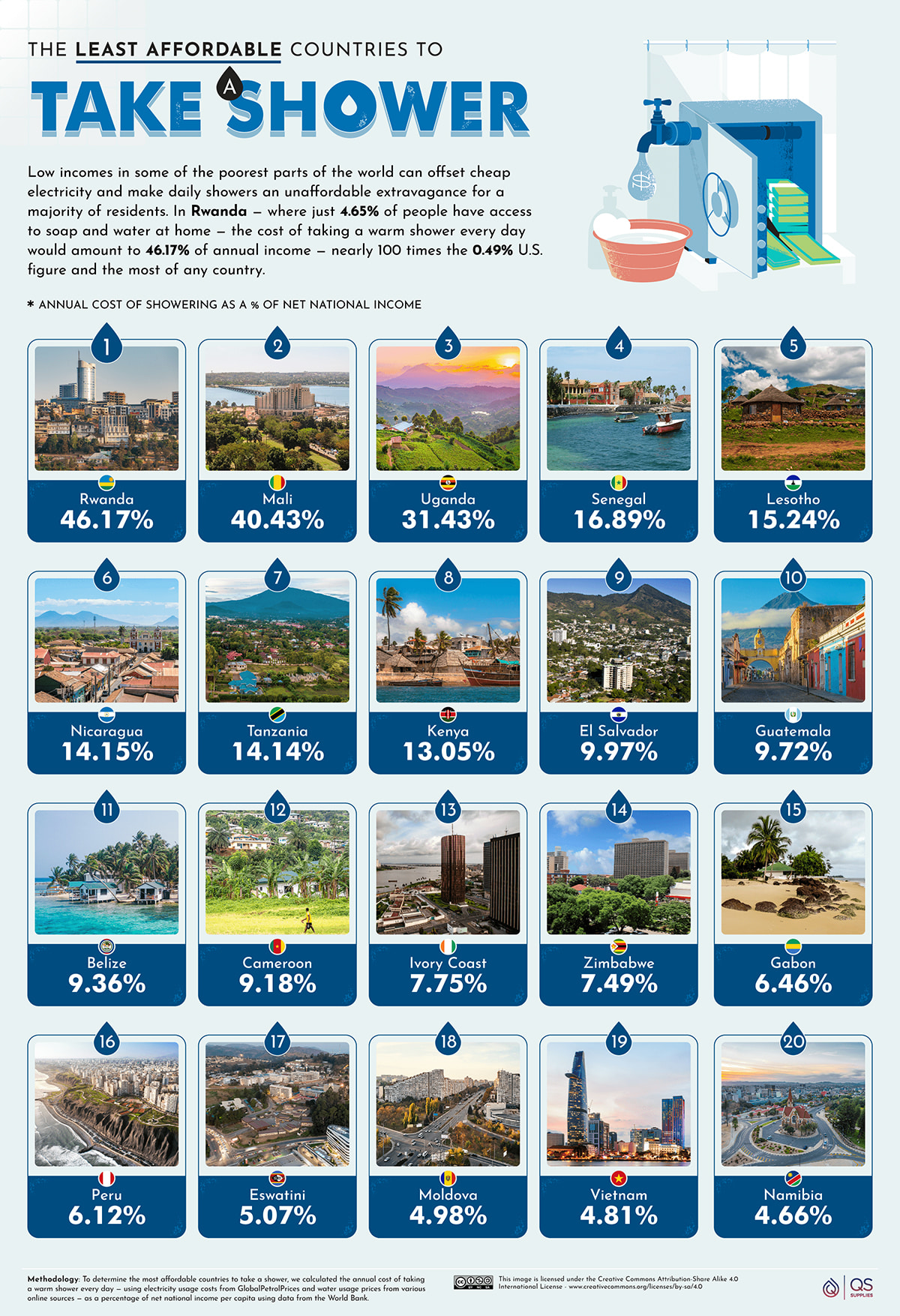 Click here to view full
size
Click here to view full
size
Our table of the least affordable countries to take a shower is dominated by African countries. Rwanda, Mali and Uganda each balance a three-figure average salary against utility costs that are higher than those in some of the richest countries in the world. But the cost of turning on a tap is not the first obstacle Rwandans face in accessing a daily shower: just "5 per cent of households in Rwanda have a place for family members to wash their hands with soap," according to Unicef.
With Power Shower Comes Responsibility
With the energy crisis still playing out, our study provides a timely reminder that although affordable sanitation is a basic human right, a daily hot shower is far from a universal norm.
Those put off by high utility bills might instead think of showers in terms of quality rather than quantity - since a long, daily shower can be both pricey and detrimental to your skin. Dermatologists recommend an ideal shower time of no more than five-ten minutes to get clean without dehydrating your skin. In the UK, you can expect your shower to work out cheaper than a bath if you stick to the lower end of this range, while a ten-minute shower is likely to cost more than a soak in the tub.
Consider taking fewer showers but taking the time to ritualize the event by enjoying the bathroom environment you've created, and you can get the sense of indulgence without the big bills to match.
You can explore our full data on the cost of taking a shower around the world in the interactive table below.
METHODOLOGY & SOURCES
To determine the cost of showering around the world, we calculated the annual cost of taking a warm shower every day in each country.
First, we sourced the price of water per litre and the cost of electricity per kWh for 89 countries in their local currencies. Electricity usage costs per country were sourced from GlobalPetrolPrices. Water usage prices per country were sourced from local government sites, news articles or guides from local water companies that detail the price structuring of water usage.
To calculate the cost of electricity usage from showering, we used a tool via POWER Calculation based on the formula E = C*V*DeltaT/PR, where:
E = energy in kWh
C = Specific heat of water - 4.187 kJ/kgK or 1,163 Wh/kg°C
V = volume of water to heat
deltaT = Th-Tc (Th = temperature of hot water; Tc = temperature of input cold water)
PR = performance ratio (including losses of heat through pipes and tank), default value = 0.9
Water usage costs vary between flat rates, price brackets for household sizes and cost per unit. In any scenarios that provided price brackets or distinctions between types of household, we assumed usage from showering would be equivalent to no more than 1,818 litres per month (the U.S. average) and that the usage was from a residential, average-sized household for that country. The cost of sewage treatment was not included in our final pricing per country.
For each country we summed together the output of the above formula's electricity cost for a year's worth of showers and the equivalent year's spending on water under the assumption that each country uses the same amount of water as the U.S. average when showering - 59.8 litres per shower, once per day for 365 days.
To measure the affordability of showering for each country, we then compared the annual cost of showering to a country's annual net national income per capita, as sourced from the World Bank.
Local currencies were all converted to U.S. dollars. The data for this research is correct as of August 2023.






